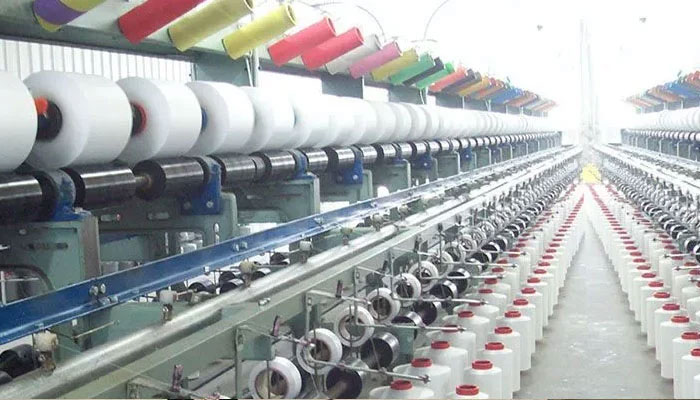Textile exports fall 3.1 percent in February
The downtrend was mainly due to downbeat value-added sector that is a key to drive exports growth.
ISLAMABAD: Textile exports fell 3.1 percent year-on-year and 6.8 percent month-on-month to $1.2 billion in February, the official data showed on Tuesday, as less number of working days during the month compounded the negative impact of high yarn price.
In February, exports of knitwear and bedwear fell 13 percent and 1.2 percent year-on-year, respectively, according to the Pakistan Bureau of Statistics (PBS). The decline was carried out from 10.3 and 7.3 percent contraction month-on-month.
The downtrend was mainly due to downbeat value-added sector that is a key to drive exports growth. However, exports of basis textiles increased.
In February, basic textiles exports – cotton yarn, cotton cloth, non-cotton yarn, and raw cotton --increased 13 percent month-on-month. However, value-added sector and other textiles witnessed a decline of 11 and 10 percent, respectively.
Textile exports declined mainly due to 11.6 percent decline in volumetric sales, said Topline Research.
Exports declined 6.7 percent in dollar terms and 7.3 percent in rupees term due to lower number of working days in February. “In last six years, February textile exports have fallen in range of 1-10 percent – except for February 2020,” the brokerage said in a flash note.
Within basic segment, cotton yarn increased 40 percent month-on-month to $120 million thanks to 35 percent rise in quantity that was exported.
Within value-added segment, knitwear, bedwear, towel and ready-made declined 10, 7, 11 and 15 percent month-on-month, respectively. In 8MFY2021, textile exports rose 6.6 percent to $10 billion, up 11 percent in rupee terms, due to the benefit coming from diversion of orders from India, and Bangladesh. Similarly, US-China trade war has also helped textile exports of Pakistan, said Topline Research.
Value-added sector for 8MFY21 witnessed an uptick of 12 percent to $6.9 billion due to better pricing.
The monthly declining trend in textile exports that account for over 60 percent of total exports is a bad sign for the economy that is struggling to come out of sluggish growth cycle.
Exports had recovered to pre-COVID monthly level of $2 billion in September, October and November and the recovery was due to low value-added apparels and home textiles.
Exporters have been warning of falling exports due to increase in yarn prices amid cotton shortage. If the government doesn’t take up the matter seriously, the gains it is taking due to diversion of export orders could be lost.
Pakistan couldn’t benefit from the US trade restrictions on China to increase exports due to much reliance on cotton-based textiles contrary to the growing global demand of manmade fibres, Ehsan Malik, chief executive officer of Pakistan Business Council said in December last. The country’s export portfolio is largely cotton based, whereas there is a fastest growth in demand of manmade fibres in the international market and the US, the biggest destination for Pakistani goods, Malik said.
-
 Trump Trolls European Leaders With AI Map Showing Greenland As U.S. Territory
Trump Trolls European Leaders With AI Map Showing Greenland As U.S. Territory -
 AI Vs Reality: How Deepfakes Are Warping Story Of Maduro’s US Capture
AI Vs Reality: How Deepfakes Are Warping Story Of Maduro’s US Capture -
 Why Ryan Coogler Got Worried After Pitching 'Sinners' To Michael B Jordan
Why Ryan Coogler Got Worried After Pitching 'Sinners' To Michael B Jordan -
 Princess Diana's Brother Shares Emotional Post After Prince Harry Returns To UK Without Meghan, Archie, Lilibet
Princess Diana's Brother Shares Emotional Post After Prince Harry Returns To UK Without Meghan, Archie, Lilibet -
 'Disgraced' Andrew Gets Away With Major Double Standard Over Royal Lodge
'Disgraced' Andrew Gets Away With Major Double Standard Over Royal Lodge -
 Carson Beck Girlfriend Rumours Explained Amid CFP Championship Run
Carson Beck Girlfriend Rumours Explained Amid CFP Championship Run -
 Sean Penn's 'very Human Reality' Leaves Madonna Horrified
Sean Penn's 'very Human Reality' Leaves Madonna Horrified -
 Fernando Mendoza Girlfriend: Is The Indiana QB Dating Anyone?
Fernando Mendoza Girlfriend: Is The Indiana QB Dating Anyone? -
 King Charles' Decision 'not Good Look' For Prince Harry Amid UK Court Case
King Charles' Decision 'not Good Look' For Prince Harry Amid UK Court Case -
 South Korea Announces First Set Of New Space Technologies
South Korea Announces First Set Of New Space Technologies -
 Jimmy Butler: Warriors Star Awaits MRI Results After Knee Injury
Jimmy Butler: Warriors Star Awaits MRI Results After Knee Injury -
 Blake Lively Gushes Over Ryan Reynolds Amid Feud With BFF Taylor Swift
Blake Lively Gushes Over Ryan Reynolds Amid Feud With BFF Taylor Swift -
 Prince William 'furious' At Meghan Markle, Harry
Prince William 'furious' At Meghan Markle, Harry -
 Church Under Investigation After Anti-ICE Protest Interrupts Worship
Church Under Investigation After Anti-ICE Protest Interrupts Worship -
 UK Govt Tightens School Rules On Phones And Social Media
UK Govt Tightens School Rules On Phones And Social Media -
 Fernando Mendoza’s Mom Steals Hearts After Indiana Wins National Championship
Fernando Mendoza’s Mom Steals Hearts After Indiana Wins National Championship




